Our History
First Presbyterian Church’s heritage, history and growth have been intertwined with that of Lynchburg for over 200 years. Our church was founded in 1815 (some 29 years after Lynchburg was established in 1786) and has served its congregation and the Lynchburg community in four different church locations throughout those years and will into the future.
As one of the oldest churches in Lynchburg, we are grateful to have had the opportunity to provide a constant spiritual and educational influence in the Lynchburg community. A growing and transforming congregation has led in fostering new churches in the community as well as been leaders in education through the Weekday School and other educational opportunities.
The First Church
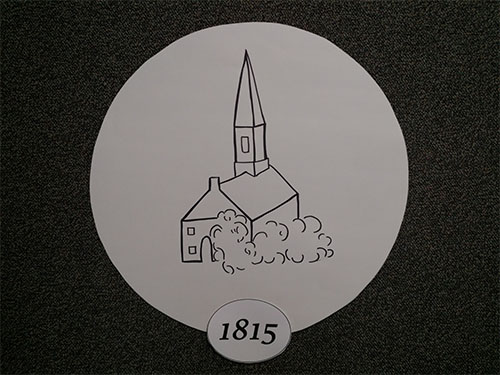
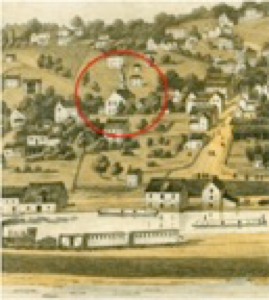
Installed Pastor:
- Rev. Dr.William S. Reid (1822-1849)
In 1813 Dr. William S. Reid began the work of the church through meeting with members of the community in their homes. The beliefs and convictions of this group culminated in forming a new church, First Presbyterian Church, on March 20, 1815. Dr. Reid was appointed pastor at an annual salary of $300! At this time the congregation numbered 15, including two infants.
Perspective: When the church was founded, James Madison was the 4th President of the United States, and Ludwig von Beethoven had just premiered his Symphony No. 8 at age 45.
The Second Church
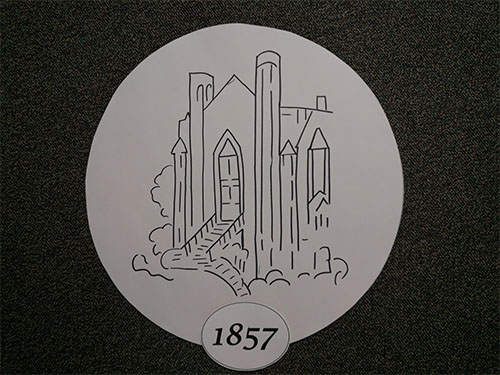
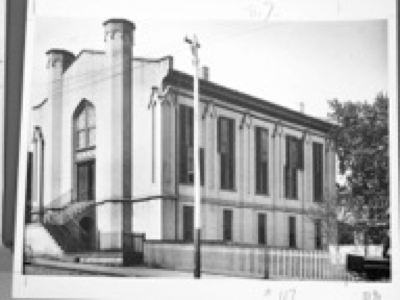 The 2nd First Presbyterian Church fronting on Main Street in Lynchburg.
The 2nd First Presbyterian Church fronting on Main Street in Lynchburg.
Note the absence of a steeple! The building was dedicated in 1858 and served our congregation for almost 41 years.
Installed Pastors:
- Rev. Dr. C.R. Vaughan (1849-1858)
- Rev. Dr. Jas. B. Ramsey (1858-1870)
- Rev. Dr. E.H. Barnett (1870)
- Rev. Dr. Richard Mc Ilwaine (1870-1872)
- Rev. Dr. William T. Hall (1872-1896)
In 1854 a severe storm badly damaged the steeple of the original building, requiring the construction of a new building. Then-Pastor Dr. Vaughan contemplated building the new church on the southeast corner of Church and 11th Streets, but property title difficulties caused the new church to be constructed on Main Street.
Perspective: During this period James Buchanan was our 15th President. As well, Abraham Lincoln and Stephan Douglas had conducted the first of their famous debates and Theodore Roosevelt was born.
The Third Church
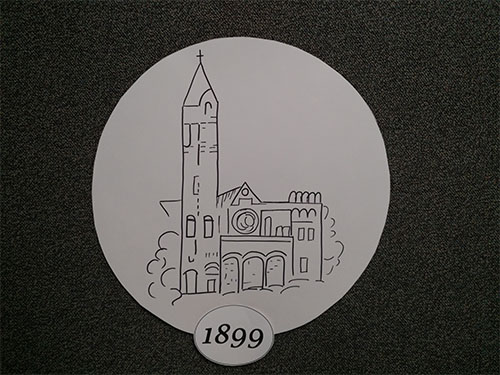
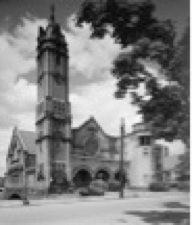 The 3rd First Presbyterian Church at 9th and Court Streets
The 3rd First Presbyterian Church at 9th and Court Streets
Certainly the steeple is prominent here!
Installed Pastors:
- Rev. F.T. McFaden (1896-1904)
- Rev. Dr. Jas. D. Paxton (1904-1930)
- Rev. Dr. F. Campbell Symonds (1931-1937)
- Rev. Dr. Russell C. Stroup (1938-1950)
By the early 1880s the congregation had grown considerably. By 1898 the congregation numbered 405 members and services were crowded at times. As well, the congregation was growing quickly – between 1896 and 1897 fifty-one members were added, an increase of 13%.
Perhaps more significantly, by this time a large portion of the congregation now lived south of Main Street, putting them farther from the 1858 church. Dr. Hall, pastor at the time, noted in 1892: “The growth of the city has been steadily away from the location, increasing the disadvantages every year... We are moving now to get a position where we will be as convenient as possible to the whole congregation.”
So, the cornerstone for the new (3rd building) was laid on July 5, 1899, at 9th and Court Streets. Between the sale of the old property and contributions, the entire $49,000 was underwritten.
A new wing was added to the church in 1941 to house its Sunday schools and other community education programs. When the property was transferred to the City of Lynchburg in 1998, these spaces would be, and still are, utilized by the Lynchburg Police Department.
During the World Wars of the 20th century, 57 men (7%) of the congregation served in the armed forces during World War I. A total of 113 men and women served during World War II, 16% of the congregation at the time.
Dr. Russell C. Stroup, requested a leave of absence in 1942 in order to join the Chaplains Corps. He served in the 6th Infantry Division in the South Pacific and the Philippines, receiving the Bronze Star for heroism in action at Luzon. He returned to the congregation in 1945.
Perspective: In 1900 William McKinley was the 25th President. The Lynchburg Foundry was established, the US went on the gold standard and three local colleges were founded: Randolph–Macon Woman's College (1891), Sweet Briar College, (1902) and Lynchburg College, (1903).
The Fourth Church
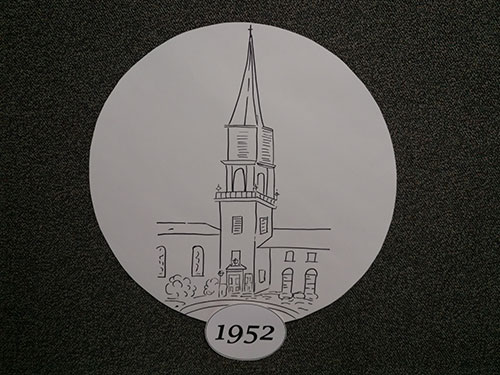
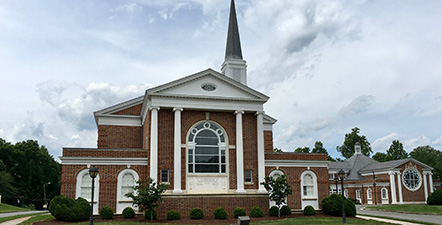 The 4th First Presbyterian Church
The 4th First Presbyterian Church
1215 VES Road, Lynchburg in 1952
Installed Pastors:
- Rev. Dr. Emmett B. McGukin (1950-1967)
- Rev. Dr. S. Albert Newman (1965-1966)
- Rev. Herbert B. Barks (1967-1971)
- Rev. Robert A. Helstrom (1970-1976)
- Rev. Jerold D. Shetler (1971-1975)
- Rev. Edward K. Beckes (1974-1977)
- Rev. Timothy L. Croft (1976-1978)
- Rev. Bernard K. Bangley (1977-1980)
- Rev. Dr. John R. Killinger, Jr.
- Rev. Dr. Robert H. Bullock, Jr. (1981-1983)
- Rev. John H. Thompson
- Rev. Dr. Richard Harbison (1987-1997)
- Rev. Dr. Walter R. Smith (1989-2006)
- Rev. Dr. James J.H. Price
- Rev. Arthur F. Fogartie (1998-2001)
- Rev. L. Tyler Downing (2001-2005)
- Rev. Dr. John M. Scholer (2002-2014)
- Rev. Meggan Means Farwell (2007-2012)
- The Rev. Dr. Peter A. Thompson (2016- Present)
- Rev. Chad C. McCain (2018-2020)
As automobiles came into common use in the 1930s and 1940s, congregants increasingly moved to homes in the suburbs. By 1948 it was evident to members of the Session that the church would need to move.
“ . . . Seventy percent of our active membership now resides in the Rivermont-Peakland area. Eighty percent of our Sunday School and eighty-seven percent of our cradle roll babies come from this section (of town). “Since a church is a congregation rather than a building, we are already located in Peakland and it only remains for us to establish our physical facilities where our actual church is.”
The church building was completed 1952 at a total cost of $490,000. Services began on September 6 of that year, conducted by Dr. Emmett McGukin in the new Sanctuary designed to hold 494 people. Dr. McGukin delivered the first sermon titled, “The Things Our Fathers Dedicated." Dr. Stroup was present for the service and delivered a series of vesper services that month.
When the 3rd First Presbyterian Church building on Court Street was sold to the First Methodist Church, the contract of sale explicitly authorized First Presbyterian to remove five memorial windows and move them to the V.E.S. Road church. Three of the windows are installed in rear Narthex wall, one is installed in the front wall of the Chapel, and the fifth installed in the rear wall of the Sanctuary over the antiphonal organ.
Plans for the new Sanctuary included installing new stained glass windows on both sidewalls. Funds were raised, and the Sanctuary now features stained glass windows depicting important events in Biblical history. To learn more about the stained glass windows at FPC click here!
The growth of the Church School, Youth Groups, Men of the Church, Women of the Church, Weekday School, and other church organizations resulted in a 1999 church addition that continues to provide our Fellowship Hall, kitchen facilities, and a number of classrooms.
Expansion and growth continued with the “Our Time To Grow” campaign in the 1990s. Included were an expansion of the Fellowship Hall, expansion of the Narthex, and the addition of our Columbarium Garden.

